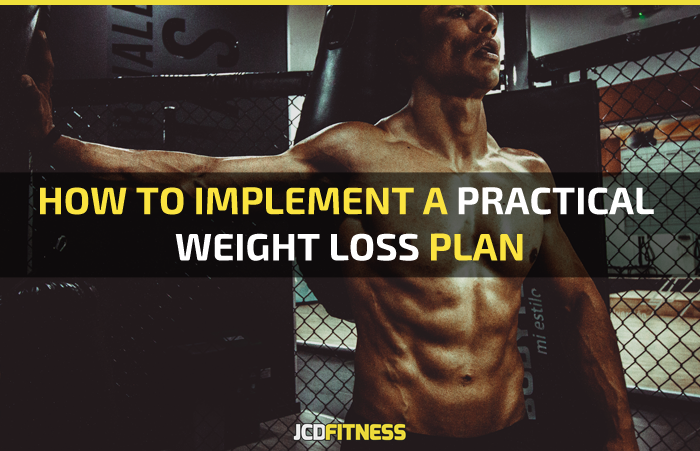
But what you might not realize is that while having a plan in place is great, it’s only the beginning. There are many factors that must be covered in order to be successful in your fat loss efforts, so I’m going to show you all the steps necessary.
But what you might not realize is that while having a plan in place is great, it’s only the beginning. There are many factors that must be covered in order to be successful in your fat loss efforts, so I’m going to show you all the steps necessary.
Here’s a short table of contents to easily navigate if you want to jump to the area most interesting to you:
- Why you want to lose fat, not just weight.
- Training Matters (here’s why).
- Dietary Factors (don’t miss these).
- Stress and Rest: do you have the right balance?
- Your mindset might matter more than you’d expect.
A Weight Loss Plan Must Be Optimized For Fat Loss
When you start a weight loss plan, fat loss must be the main goal because if you only slash calories and limit your training, you’re bound to end up losing muscle instead of fat.
And when that happens, you’re going to lose strength as well.
But not only will you lose strength, your body composition won’t change too much.
What I mean is you’re likely to end up losing weight and turning into a smaller version of your former self with only a slightly lower body fat percentage.
This is also known as the “skinny-fat” look.
If you’re reading this, I can safely assume you want to be leaner, more defined, and have some muscle to show for your efforts. If that’s not you, just disregard this information altogether. ;)
So how is a weight loss plan optimized for fat loss? There are 3 main keys:
- You train with weights, focusing on progressive overload and utilize intense cardio instead of long bouts of steady-state cardio (some is okay)
- You consume enough protein, carbs, and fat with a slight caloric deficit (this helps spare your muscles and burn mostly fat)
- You have a set training and dietary plan to follow and you stick to it the best you can over a period of time.
So let’s get into the details.
Training Intensity, Strength Maintenance, And What To Expect
When on a weight loss plan, your main form of activity should be in the form of weight training. Weight training allows you to maintain and even build muscle while in a caloric deficit.
I’ve written on this before:
Weight Training For Women and Hypertrophy Training (more suited for men) are good starting places.
But for the most part, this is what matters most:
- Train 3 to 5 times each week
- Train each muscle group 1 to 3 times per week
- Total training volume should be adjusted to a point of being able to recover (err on the side of caution when in doubt)
When you’re training during the week, your schedule availability is what will determine the type of workout plan you follow. So if you can only train 3 days per week, a full-body split, upper/lower split, or a combination of the 2 is your best bet.
On a full body split (like my beginner workout routine), you’ll be hitting each muscle group an average of 2 to 3 times per week depending on exercise selection.
However, some people are going to struggle with recovery on a diet trying to do 3 full-body sessions per week. So a way I like to mitigate this is by doing a lower body session on Monday, an upper body session on Wednesday, and a full-body session on Friday or Saturday.
If you can afford to train 4 or 5 days per week, then an upper/lower split makes more sense because it will allow you to spread out the volume (sets and reps) over more days, which can be good for recovery, and for muscle repair via protein synthesis.
Here’s a sample of what that training could look like:
Monday – Lower Strength
Squats | 4×5
Hyperextension | 2×10-12
Leg extensions | 3×12-15
Dumbbell Romanian Deadlift | 3×8-10
Seated calf raises | 4×12-15
–
Tuesday – Upper Strength
Incline Bench Press | 4×5
Weighted Chin-up | 4×5
Flat Dumbbell Bench Press | 2×8-10
Seated Cable Rows | 2×8-10
Seated DB Lateral Raises | 3×12-15
Cable Face Pulls | 3×12-15
–
Thursday – Chest/Triceps/Shoulders
1. Incline DB press | 3×8-12
2.Decline Bench Press | 2×8-10
3a. Flat DB Squeeze Press | 3×10-12
3b. DB Rear Lateral Raises | 3×12-15
4. DB Military Press | 3×6-8
5a. Rear Cable Lateral raises | 3×12-15
5b. Arnold Presses | 3×10-12
6. Skull Crushers | 3×8-10
–
Friday – Thighs/Hamstrings/Calves/Abs
1.Leg press | 3×10-12
2. Weighted hyperextension | 3×10-12
3a. Leg extensions | 2×12-15
3b. Lying leg curl | 2×8-10
4. Standing Calf Raises | 35 reps
5a. Seated Single-leg Calf Raises | 3×10-12
5b. Physio Ball Ab Rollouts | 3×15-20
–
Saturday – Lats/Traps/Biceps
1. Close-grip Lat Pulldown | 3×8-12
2. Single-arm DB Rows | 2×8-10
3a. Seated Cable Row | 2×10-12
3b. Seated DB Shrugs | 2×12-15
4a. Face pulls | 3×12-15
4b. Seated EZ Bar Curls | 3×10-12
5a. Band pull-aparts | 3×8-10
5b. DB Hammer Curls | 3×8-10/arm
When training on a fat loss diet, you’re not likely to be setting any personal records because full recovery is going to be compromised as a result of a being in a caloric deficit.
So I think it’s wise to manage your expectations and understand that at best, you’ll maintain your strength (weight on the bar and total reps), and for some, you might experience a temporary drop in strength over time, but I don’t think it should ever be more than 10-15% in total.
Example: If at the start of your diet, you’re lifting 225 pounds for 10 on the bench press, it’s acceptable to drop down to 200-205 pounds for 8-10 reps, especially when dieting for longer than 12 weeks.
If you lose more strength than this, it’s likely that your deficit is too steep, you’re not getting enough sleep or your overall stress load is too high and avoiding the drops is impossible.
Now this leads to our next topic. How do you manage your diet to lose mostly fat and not muscle?
Dietary Factors Influence The Type Of Weight You Lose
When it comes to how dietary factors influences your weight loss plan, it all comes down to the following, in this order:
- Net caloric deficit over a period of time
- Sufficient protein intake (1 gram per pound of body weight)
- Sufficient carbohydrate and fat intake (no low carb stuff here)
- Micronutrient balance (hmmmm, liver)
- Food management (planning and structure)
A. A Caloric Deficit Is Necessary
To lose fat, we know one thing for certain.
You must maintain a caloric deficit. A caloric deficit is simply putting yourself into a negative calorie balance, meaning you’re consuming less than you’re burning. No matter what fancy diet you follow, if you’re not in a caloric deficit, your weight loss plan isn’t going to work.
Read: How To Create A Caloric Deficit To Lose Weight.
B. You Must Eat Enough Protein
Consuming protein above and beyond the RDA is necessary for the exercising population, and it’s especially true for those lifting weights. The current RDA (recommended daily allowance) for protein is currently set at .8 grams per kilogram of body weight.
To put this into perspective, it comes out to about 72 grams of protein for a 200 pound (90 kilogram) man. The RDA is merely a guideline to keep someone healthy and free from disease.
For weight training folks like us, we need more. I recommend about 1 gram per pound (2.2 grams per kilo) of body weight. To read more about that, check out how much protein do you need?
C. You Need Enough Carbs And Fat
When going on a weight loss plan, it’s common to pick a fad diet and cut out all your carbs or fat. Why? Because it’s easy to cut out entire food groups, but only for a while. It’s not sustainable in the long run.
For more info on why, read 3 Reasons Fad Diets, Detoxes, and Quick-Fixes Are Keeping You Disappointed And Out Of Shape and watch the video below:
—
To put it simply, we need fat in our diet to cover our fatty acid requirements and because some vitamins are only fat soluble (meaning how they’re dissolved and used in the body). So if you go super low fat, you might not be able to absorb and use Vitamin A, E, D, and K efficiently.
I like to aim for 15-25% of total caloric intake for grams of fat.
For carbohydrates, I’m a big fan of keeping it matched to, or higher than your protein intake on a diet. I’ve covered this a bunch in the past, but for a refresher, you can read don’t fall for the low-carb trap.
But it won’t be this way for everyone due to variances in expenditure, body weight, size, and personal dieting history.
Here are the cliffs:
Carbohydrates are good for the following reasons:
- Your brain uses glucose as its primary fuel (up to 20% of your daily expenditure).
- Carbohydrates spare protein by providing enough energy for your muscles to use in the form of glycogen (if you get too low, your body will use protein as sugar, and it’s a very stressful process).
- They help you maintain a high intensity while lifting weights which is important for strength maintenance and the proper intensity to preserve and grow muscle mass.
D. Micronutrient Balance
If you’re eating a well-rounded diet full of whole food, then you should be covered on vitamin and mineral intake. You get micronutrients from all of your food, but some are denser than others. An example is to look at foods like beef liver and raw oysters. If you struggle to get vitamin A, then a small serving of 100 grams of beef liver will load you up on enough Vitamin A for the week.
The same goes for oysters, but with regards to zinc. Oysters are loaded with zinc, and you could get enough zinc to last you for a week by having only 3-4 raw oysters. If you know you need more zinc, having oysters is a way better option than supplements or trying to get it through other sources like meat or dairy (which contain low amounts of zinc relative to oysters).
I’ve written more about getting plenty of nutrients through a varied diet. You can check it all out in this weight loss meal plan article.
Here’s a post on my Facebook page all about liver and Vitamin A.
E. You Must Have A Plan To Manage Your Intake
As the old saying goes… if you fail to plan, you plan to fail. While I don’t write meal plans, nor do I recommend them, I’m a fan of having a set structure of goal macros to meet each day.
However you decide to meet them is up to you, but here’s a simple outline of what I think makes sense for most people, and what I believe to be very practical:
- 3-4 meals per day
- Structured eating times (breakfast, lunch, dinner, snacks)
- Mixed meals every time you eat (each meal contains protein, carbs and fat)
- Uniform eating for most meals (makes your planning much easier)
- Have a plan for portion sizes (how to portion out a recipe)
Check these resources: pre-workout meal guide and eating fat in your post-workout meal.
Stress Is Stress, Rest Is Rest: Are You Balanced?
Most of the programs I create for clients consist of 3 to 5 days of training (weights and cardio) and 2-4 days of total rest. The reason for this is because exercise is stressful, but it’s not the dose of exercise that causes one to overtrain or impair recovery.
It’s the stress outside of training that pushes us over the edge. Our jobs, our home life, our road rage — pretty much all of the worries of the modern western world is what causes the most stress in our lives.
As a result, we have to limit training to the dose that will create the changes we want without leading to loads of burnout.
If we were all lucky enough to not worry about money and live easy, care-free lives on the beach with lots of sun, we could all train 2-3 hours per day, every day and rarely break down. But most of us don’t have that luxury.
Balancing stress is a process of getting enough sleep, eliminating things from your life that cause unnecessary stress, while taking breaks and implementing periods of relaxation when you need it most (like the end of a hard 8-week training program).
Some ways to deal with stress:
- Spend time in silence each day (even if it’s just 5 minutes)
- Plan as needed to control most of your day
- Have a bedtime ritual (get enough sleep)
- Eliminate things in your life causing you stress when possible
- Spend time in nature (if that’s your thing)
Your Beliefs Influence Your Actions
If you don’t believe you can make improvements, you probably won’t. There’s some interesting research by Carol Dweck about fixed and growth mindsets.
You can read more about the experiments and research, but here’s the gist:
- Those with a fixed mindset believe they’re static and cannot change or improve.
- Those with a growth mindset believe they’re capable of learning new ideas and improving with practice.
A quick example: When I was in junior high, I was placed in advanced mathematics one year ahead of my peers. Starting out in 8th grade, all of the sudden I was one of a handful of kids sitting in algebra 1 class with 9th graders.
Being an introverted kid, I was intimidated and I found myself getting behind pretty quickly. I was always stressing about new concepts, dreaded tests, and found myself getting C’s and B’s when I was mostly a straight A student up until this point.
I began to believe that I wasn’t any good at math. And my belief influenced the next 3 years of school. The following year I had geometry and I struggled. The next year (10th grade), I was in algebra 2, and it was the algebra 1 woes all over again—feeling stupid, dumb and inadequate.
I was still struggling, getting behind with my schoolwork, but I was afraid to ask for help because I was supposed to be this really smart kid in advanced classes.
It wasn’t until my junior year taking college level algebra and trigonometry that something clicked for me. I had an amazing teacher who saw how I struggled with math. I believed that I just wasn’t smart enough, so I gave up quickly when presented with problems.
She worked with me after class and encouraged me to spend some time learning the concepts with her one-on-one and everything changed because she helped me believe that I could be good at math.
After she proved to me that it was within me to understand the concepts and actually work out the equations, I began to see that I wasn’t dumb all along. I just got behind because of my shyness 3 years prior, and that event led to me to believing “I just didn’t have it.”
What’s worse is somewhere along the line of getting behind, I adopted the false idea that “I wasn’t any good at math” and that belief predicted my outcome, which was struggling, falling behind, and worrying a ton about my GPA.
But once my teacher instilled the belief in me by showing me I could do it, math wasn’t super intimidating anymore. I WAS the smart kid all along, but I adopted a bad belief, which influenced my actions of hardly trying and giving up too easily.
So keep the following in mind.
If you ever find yourself saying you can’t do something, or it’s just not possible, or you don’t have time, or you know you’ll always fail, analyze those thoughts and ask yourself if it’s really true.
Most of the time, those thoughts and ideas are not true. They’re just false beliefs we’ve picked up along the way. The truth is if someone else can do something, you probably can too.
To learn more about this concept, check out my health habits article and read the section about identity-based habits. If you can take on the identity of someone who’s good at whatever you want to be good at, you’ll start to act and perform similar habits as them.
And over time, you’ll begin to work toward a similar outcome.
—
If you need personal help building a sustainable, practical weight loss plan, you can apply for 1-on-1 coaching.





3 thoughts on “How To Implement A Practical Weight Loss Plan”
Comments are closed.